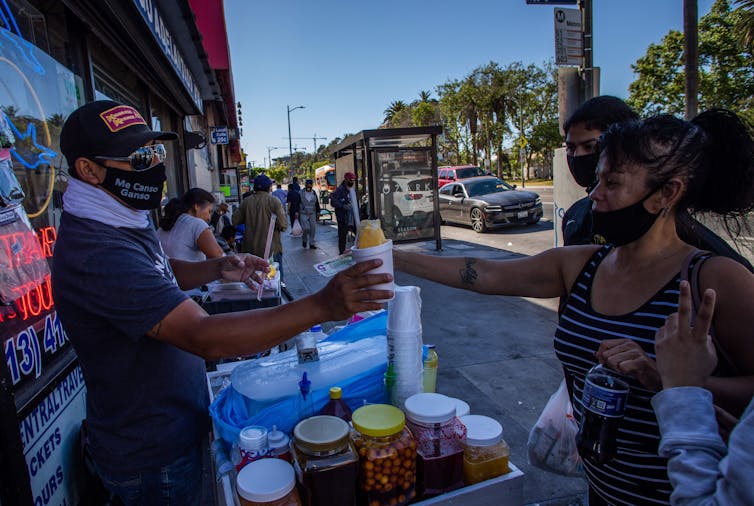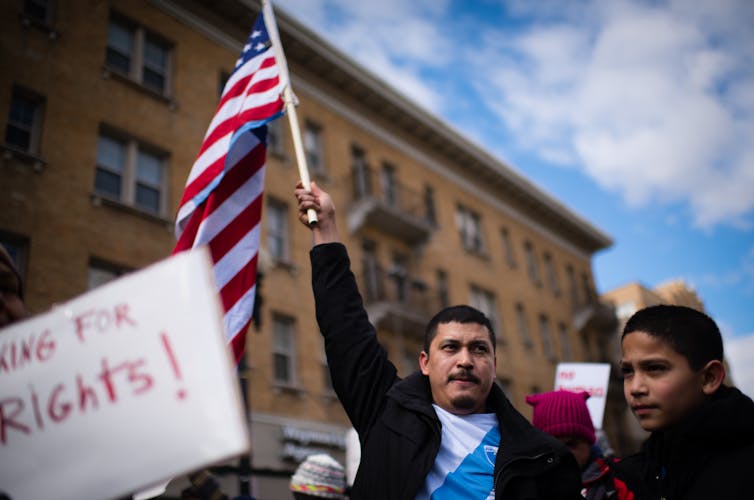Robert M. Adelman, University at Buffalo and Lesley Reid, University of Alabama
 |
| Donald Trump has repeatedly claimed that undocumented immigrants cause more crime, but new research suggests the opposite might be true. Apu Gomes/AFP via Getty Images |
Undocumented immigration does not increase the violent crime rate in U.S. metropolitan areas.
In fact, it may reduce property crime rates. These are the key findings from our recently published article in the Journal of Crime and Justice, co-authored by Yulin Yang, James Bachmeier and Mike Maciag.
Research shows that the American communities where immigrants make their homes are more often improved by their presence than harmed by it.
Immigrants bring social, cultural and economic activity to the places they live. That makes these places more vital and safer, not more dangerous.
Why it matters
People from all social groups and backgrounds commit crimes. But undocumented immigrants, and immigrants more generally, are often baselessly blamed for increasing crime rates – including, repeatedly, by President Donald Trump. In the second and final presidential debate, Trump again claimed undocumented immigrants are rapists and murderers.
This notion has existed and been studied since the early 20th century, including in a 2005 analysis we conducted with a number of colleagues that concluded immigration did not increase crime rates in U.S. metropolitan areas.
But this research is often dismissed because most empirical studies cannot separate undocumented immigrants from the total immigrant population. That level of analysis is necessary to draw conclusions about the relationship between undocumented immigration and crime.
 |
| Immigrants, including those who are undocumented, often make the American communities they settle in safer. Sarah L. Voisin/The Washington Post via Getty Images |
For example, we found in a 2017 study with colleagues that from 1970 to 2010 metropolitan areas with greater concentrations of immigrants, legal and undocumented combined, have less property crime than areas with fewer immigrants, on average.
Critics suggested that our findings would not hold if we looked at only the subset of undocumented individuals.
So we decided to find out if they were right. Our new study is the result of that effort, and it confirms our original findings: Undocumented immigration, on average, has no effect on violent crime across U.S. metropolitan areas.
In statistical models that did identify a significant relationship between undocumented immigration and crime, we found undocumented immigration reduces property crimes, such as burglary.
How we do our work
Using two different estimates of the undocumented immigrant populations for 154 metropolitan areas in our most recent study – one from the Pew Research Center and one from the Migration Population Institute – we examined the effect of undocumented immigration on homicide, aggravated assault, robbery, burglary and larceny crime rates.
Crime rate data came from the FBI’s Uniform Crime Report program. Other data were from the U.S. Census Bureau.
Using a statistical method called regression analysis to examine the data, we found that as the size of the undocumented population increases, the property crime rate decreases, on average. And the size of the undocumented population in a metropolitan area tends to have no impact on the violent crime rate.
These findings build on the conclusions of a large 2018 study in which researchers Graham Ousey and Charis Kubrin examined 51 studies on immigration and crime published from 1994 to 2014.
What still isn’t known
Our analyses looked at broad metropolitan patterns, not the relationship of undocumented immigration and crime rates in distinct, specific places such as New York City and Los Angeles. Nor does our study address the reasons that immigration reduces crime, although there is plenty of other scholarship on that issue.![]()
Robert M. Adelman, Associate Professor and Department Chair of Sociology, University at Buffalo and Lesley Reid, Professor of Criminology and Criminal Justice and Interim Dean of the School of Social Work, University of Alabama
This article is republished from The Conversation under a Creative Commons license. Read the original article.